Alsace, a Land of Wines
| Author: Neil Bull | Published: 3rd September 2013 07:14 |
Alsace, a Land of Wines...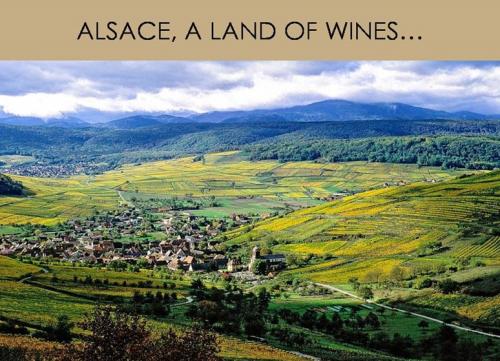
Alsace, in north east France has historically been a much disputed region. There are two possible physical boundaries between France and Germany. The mighty Rhine River to the east of Alsace and the soaring Vosges Mountains running parallel to the Rhine some 15miles to the river over to the west. Nowadays the political frontier is the Rhine, but the flat plain between the river and the mountains has been an obvious battleground whenever France and Germany went to war. Prussia gained control of Alsace in 1870. The region was given back to France under the treaty of Versailles in 1918. The Germans took control in 1940 before the region finally reverted back to France in 1945.
All this has led to the language and culture owing much to both origins. The Alsatian people maintain that they are French to their very soul. Yet most of the village names are German, most family names are German but their Christian names are often French. Many families speak Alsacien, a dialect peculiar to the region which has far more in common with German than French.
The region is famous for its villages, with half-timbered houses and fortifications that look as though they have not changed since the middle ages. One such example is Colmar, a beautifully preserved medieval market town which is known as the wine capital of Alsace.
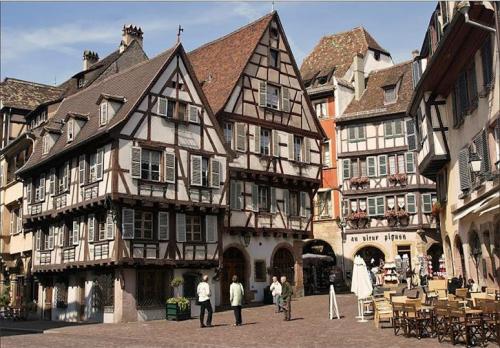
The former leather makers district has been restored and is known as la Petite Venise (little Venice) due the number of canals of the river Lauch which cut through the town. As befits a wealthy town it has many squares and fountains and is often called the most beautiful city in Europe.
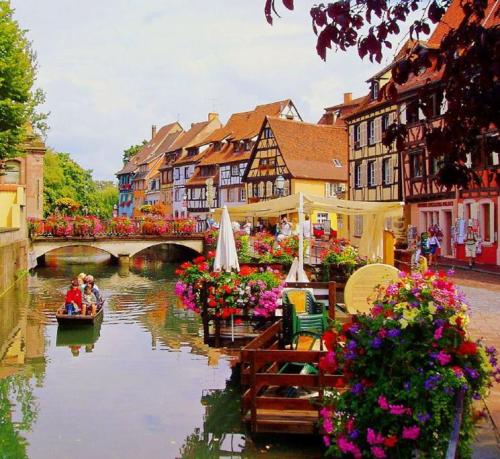
The creator of the Statue of Liberty, Frèdèric Bartholdi, lived and worked in Colmar and there is a museum in his honour which includes a large collection of his sculpture, paintings, drawings and photographs.
The Wine Producing Area.
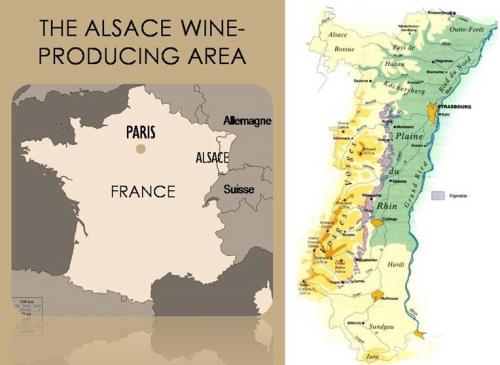
Alsace is almost as far north as vineyards can go in France, only Champagne is slightly further
north. Unlike Champagne however, Alsace has the natural protection of the Vosges mountains.
This range of peaks, rising to 1,400 metres to the west of the Rhine valley, act as a block to the
prevailing winds. Most of the rain bought by the westerly winds falls over these mountains and the forests high on the eastern slopes. By the time that the clouds reach the vineyards they have just enough moisture to throw a few refreshing showers on the vines before evaporating into the warm air. This effect, known as a rain shadow, allows Colmar, the largest town in the vineyard region, to be the second driest spot in France. Perpignan, way down in the south of the country, is the driest.
Being this far south, Perpignan with its long, hot summers produces red wines that at best can be described as 'rough and ready'. Whereas Alsace, due to the cooler northern temperatures and with the Vosges keeping the sky clear of clouds for weeks on end, allows the grapes to reach perfect ripeness, and therefore high alcoholic strength similar to those in the south but with the perfume and fragrance of the cooler north.
The vineyards lie on the flank of the Vosges, running north to south, at an altitude of between 180 and 360m, in a green swathe that is barley more than a mile wide. It is important for the vineyards to make the most of the sun's rays, and so most of the prime sites are on south, south east or south west facing slopes. Every nuance of the folds in the foothills is exploited in the alignment of the vine rows to catch as much sunlight as possible.

The higher the mountains are, the drier the land they shelter from the moist west winds. The best vineyards are in the central block of foothills where the mountains are highest. Further north, the mountains are substantially lower and so do not provide such an efficient rain shadow. A dense pine forest can lower the temperature of a vineyard by a full degree centigrade compared to one next to a planting of young oaks. Every detail has to be considered to obtain that all important full ripeness.
Food and Wine Matching.
The remarkably broad range of Alsace wines are defined by the complex, rich and unique terroir ( terroir is the collective combination of grapes, climate and soil ). The wines can be fresh, fruity or aromatic. This mix of styles allows Alsace wines to be paired with food dishes from all over the world.
Alsace wine making tradition is based on 7 main varietals, which appear on the label and which give the region's wines their aromatic diversity. Each varietal has its favourite soil type, the aim is to find the terroir which best suits each grape.
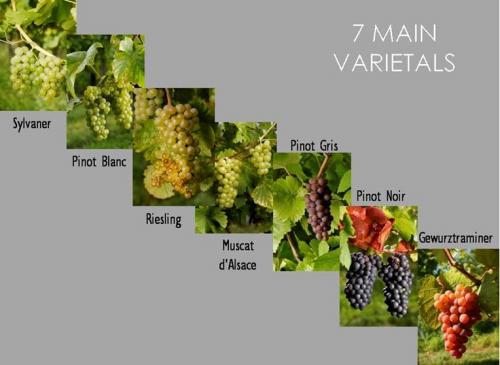
This variety of styles means that Alsace wines are drunk as an aperitif or as an accompaniment to food.
First there are the fresh and fruity wines.
Sylvaner is dry, light, easy drinking, fresh, slightly fruity and floral. It goes well with seafood and shellfish salads and charcuterie.
Pinot Blanc is a fresh, supple wine with peach and apple aromas and floral notes and is a perfect match for low sugar dishes, fish, white meat, vegetables, poultry, omelettes,quiches and mild cheese.
Riesling is a dry and elegant with a long finish. There are notes of lemon, grapefruit, lime blossom and it has a flinty, mineral edge. A wine to be drunk with fish, shellfish, white meat, poultry and goats cheese.
Muscat is an aromatic wine and is like biting into fresh grapes. It has chart characteritic musky aromas with hints of fresh cut grass, apple and citrus. A good aperitif and goes perfectly with asparagus.
Cremant d'Alsace is the sparkling wine of the region with fine, regular bubbles. Aromas of pear and apple and sometimes hints of brioche. It is excellent as an aperitif and can also be drunk throughout the meal. It matches well with seafood and white meat as well as soft cheese such as Brie or Camembert.
Pinot Noir is the Alsace varietal for making red or rosè wines. It is a fresh fruity wine with aromas of cherry, raspberry and blackberry that is a perfect foil for grilled meats.
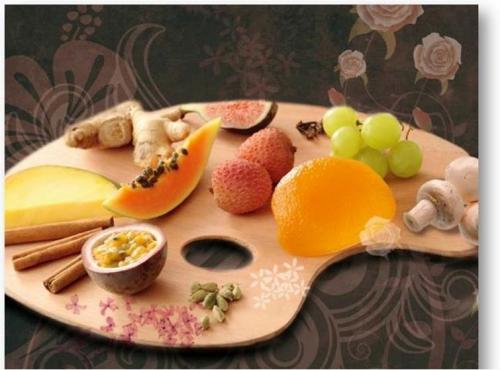
Then we come to the rich and powerful wines.
Pinot Gris is golden amber or even amber in colour with smokey, woodland notes and hints of moss, mushroom, apricot, honey and gingerbread. It is opulent and rich, complex with considerable body. Drink with Foie Gras, game and risotto.
Gewürztraminer has an intense yellow colour with strong floral aromas as well as exotic fruit such as lychees and passion fruit, pineapple and mango. It is full bodied, complex rich and with a well rounded finish. It is a wine for drinking as an aperitif and with Chinese or Thai food and strong cheese.
Pinot Noir red has note of cherry, raspberry and blackberry it is elegant and has finesse. Best served with beef, duck and game.
Alsace also produces some of the great sweet wines of the world. Vendages Tardives or late harvest wines and selections de grains nobles are deep, golden yellow with notes of honey and spice, stewed exotic fruit and dried apricots. They are full bodied, opulent and voluptuous wines. These are gourmet wines that can be enjoyed just by themselves or they are extraordinary with strong cheese and fruit based desserts.
Neil Bull
Wines Decanted
Report this article as inappropriate
Comments
You need to log in before you can do that! It's only a quick registration process to join the AMA network and completely free.



 Help
Help




 Loading...
Loading... Help
Help